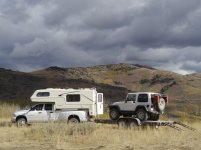ReluctantTraveler
Well-known member
I've done a lot of reading on DRW vs. super singles, and most of what I come across is strongly held (often contradictory) opinions. I imagine a lot of the discussion here will also be opinion, but I'm trying to understand the pros/cons of both options.
I'm hoping to answer the question: is DRW really a problem?
There's also a second layer regarding F-350/3500 pickup DRWs vs. F-550/5500 chassis cab DRWs, as they run on different tires.
To summarize what I've read:
Some questions:
Apologies if this is treading tired, boring ground already covered elsewhere. I'm struggling to find clear answers, probably because so much of this is subjective.
I'm hoping to answer the question: is DRW really a problem?
There's also a second layer regarding F-350/3500 pickup DRWs vs. F-550/5500 chassis cab DRWs, as they run on different tires.
To summarize what I've read:
- DRW...
- Provides better stability with a camper.
- Adds some protection in the event a tire blows out, as you have another one to fallback on while you get to the shoulder and pull over.
- Lots of commercial drivers take them on logging roads, service roads, etc. and the fear of getting a rock stuck is potential overblown.
- They might not be as good in the snow, but good tires can compensate.
- They suck in sand, because you can't really air them down.
- Super Singles...
- Might handle better in the snow (though some folks say they're worse).
- Are better in sand, because you can air them down more.
- No risk of rocks stuck between them (but might not matter).
- Less side-to-side stability with a camper on the bed, and if you get a blowout, that's the only tire so the rim might get wrecked.
- Heavier and more expensive.
- Maybe worse on highway/city roads because they're often military tires.
Some questions:
- Are DRW F-350/3500 trucks "different" from DRW F-550/5500's because they're not on steel reinforced 19.5 pizza cutters?
- Can you get smaller, non-military super singles? For example, Earth Cruiser's run Toyo 37's, but start their life as a DRW Isuzu NPR.
- Are their super single conversions that aren't $20k?
- Can you drive DRW trucks on the beach?
- Are DRW vehicles harder to fit in a parking spot?
Apologies if this is treading tired, boring ground already covered elsewhere. I'm struggling to find clear answers, probably because so much of this is subjective.
Last edited:

